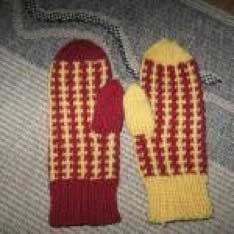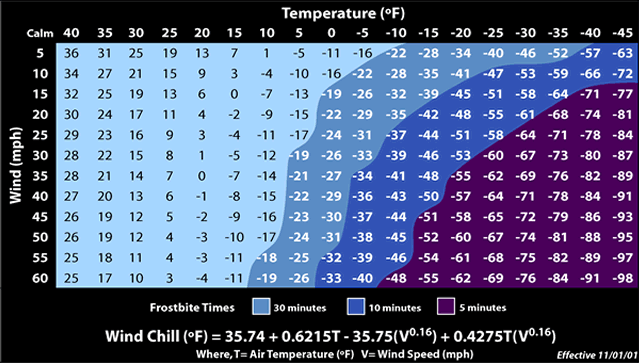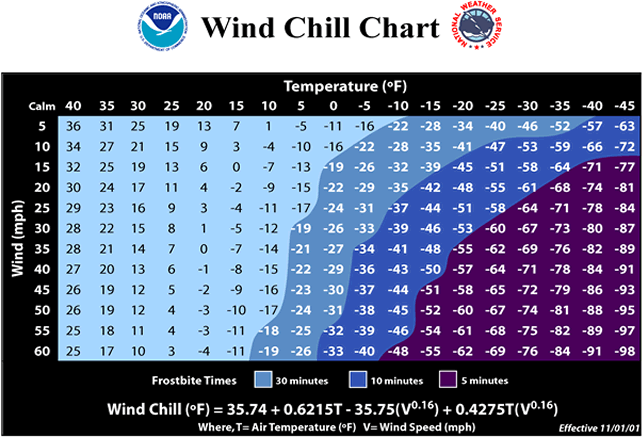Predictions for this weekend are for windchills of -20 degrees in cities, -30 degrees in the suburbs. You have a significant risk of rapid hypothermic injury. Hypothermia is a nasty, subtle, and potentially fatal condition. The sequence of hypothermia is:
- You can get hypothermic inside or outside! It is just a matter of temperature differential and lack of insulation.
- First you get cold and shiver.
- Then you get stupid – starts with the “umbles” – mumbles, fumbles, and grumbles, and stumbles.
- Then you lose fine motor coordination, higher mental functions, can’t perform simple tasks like subtraction, zip your jacket, etc.
- Then you lose consciousness. Risk of death is proportional to how long it takes to get to medical care and previous medical condition.
- No one is immune. Experienced hikers, climbers, firemen, policeman, the young, middle-aged and old have all fallen victim.
IT CAN HAPPEN TO YOU.

Wear many breathable layers
How to avoid hypothermia if you go out doors:
- Keep your skin dry. Wear synthetic fabrics as your primary layer of clothing -they wick moisture away from the skin. Wear several layers of insulating fabrics over them. Recreational Equipment, Eastern Mountain Sports, and Under Armour have everything from socks to facemasks. Almost all exercise clothing is made from synthetics. Bicycling socks make an excellent primary layer. If you don’t have access to these fabrics, then try to change socks frequently. Wet skin loses heat fives times faster than dry skin.
- Do not wear every item of clothing you own and make yourself into a tight bundle. This will not allow moisture to escape to the
atmosphere, and the wetter you get, the colder you will get. - Most of your heat loss is from head, hands and feet, so hats, scarves, mittens, and insulated boots are in order.
- Dehydration increases heat loss. Alcohol and caffeine increase water loss and should be avoided. Nicotine constricts arteries and decreases blood flow to the extremities. Drink water and warm beverages.
- It is important to eat so you have calories to burn.
- It is important to remain active, whether moving arms and legs, or taking frequent trips up and down the stadium stairs if you at a football game.
- Blankets and wind breakers are important to prevent convection loss of heat.
- Heart attacks increase in cold weather, especially with exertion such as snow shoveling, breaking ice dams, pushing a stuck car.
- Breathing frigid air can cause coronary constriction, so wearing a scarf or facemask is advisable.
- Vitamin D levels drop in the winter, and those with low levels are more likely to have heart attacks than those with normal levels. Fatty fish such as salmon, or vitamin D supplements are recommended.
- Influenza increases the risk of heart attack: the flu virus is active until March, so if you haven’t gotten your flu shot yet, it still may be useful. If you have the flu, stay indoors.
- Prolonged exertion, similar to intense exertion, also increases the risk of heart attack. The majority of people who die running the marathon do so during the last 6 miles. Cold weather is a time for gentler, time limited exertion.
- Alcohol binging, so-called “holiday heart,” causes abnormal cardiac rhythms, which are unhealthy and can also lead to heart attack.
Here are plumbing tips: For outside pipes, they should be opened a crack to drip. If you have pipes that run inside an external wall, they are also at risk to freeze, so you may need to also open kitchen or bathroom faucets a crack as well. If a pipe freezes, try to find an internal valve to open and warm the pipe gradually with a hair dryer. Do not use a torch on a pipe! A slightly higher water bill, or a longer time to thaw a pipe, don’t compare to an emergency visit bill from a plumber.
In summary: wear hats, scarves, gloves and well insulated boots, keep well hydrated and wear fabrics that let your skin breathe, and get up and move around periodically.

Plain Wool is too Porous – These mittens need covers
Frostbite
Straight temperatures aren’t all that matter. Brave adventurers (or those forced to leave their homes) should really consider wind chill — the temperature it “feels like” outside based on the rate of heat loss from exposed skin, according to the National Weather Service.
Fingers, toes, ear lobes, or the tip of the nose are the areas most susceptible to frostbite. Your body works hard to keep internal organs and your head warm, and so extremities get left behind.
Usually, when parts of your body get too cold, they turn red and hurt. Symptoms of frostbite, however, include a loss of feeling and lack of color. Anyone showing signs of hypothermia or frost bite should seek medical attention immediately.
For example, a temperature of 0°F and a wind speed of 15 mph creates a wind chill temperature of -19°F. Under these conditions frost bite can occur in just 30 minutes. In some areas of the Northern Plains and Upper Midwest, wind chill reached below negative 60 degrees, according to the NWS, when exposed skin can freeze in just freeze in 10 minutes.
In Nashua this Saturday night, if you remove your gloves/mittens, you can get frostbite of the hands in 10 minutes! Frostbite forms ice crystals in the skin cells, so do not rub the hands to warm them. Place your hands inside your jacket till you can get indoors and then place them in luke warm, not hot water. Or go to the ER. Do not be surprised if blisters form. Frostbite is a heat transfer burn. You may need further care.
Also, according to the National Weather Service, when the body’s temperature dips below 95 degrees Fahrenheit, signs of hypothermia, including uncontrollable shivering, memory loss, disorientation, incoherence, slurred speech, drowsiness, and obvious exhaustion.
Surprisingly, hypothermia can occur at any temperature lower than normal body temperature. Factors like body fat, age, alcohol consumption, and especially wetness can affect how long hypothermia takes to strike.
If you fall into water, the situation becomes drastically more dangerous.
For example, in water 32.5 degrees Fahrenheit or colder, you might not survive more than 15-to-45 minutes. You’ll undergo shock within the first two minutes and some functional disability before 30 minutes, according to the United States Coast Guard.
Check out this chart from the Personal Floatation Device Manufacturers Association:
How hypothermia affects most adults
| Water Temperature (Fahrenheit) | Exhaustion or Unconsciousness | Expected Time of Survival |
| 32.5 degrees | Under 15 minutes | Under 15 to 45 minutes |
| 32.5 to 40 degrees | 15 to 30 minutes | 30 to 90 minutes |
| 40 to 50 degrees | 30 to 60 minutes | 1 to 3 hours |
| 50 to 60 degrees | 1 to 2 hours | 1 to 6 hours |
| 60 to 70 degrees | 2 to 7 hours | 2 to 4 hours |
| 70 to 80 degrees | 2 to 12 hours | 3 hours to indefinite |
| Over 80 degrees | Indefinite | Indefinite |
Sources: Cold Weather Injury Prevention Military, Intermountain Medical Ctr., New York University Hospital, Texas Heart Institute, Emory University, Men’s Health Magazine, New England Journal of Medicine, Business Insider


